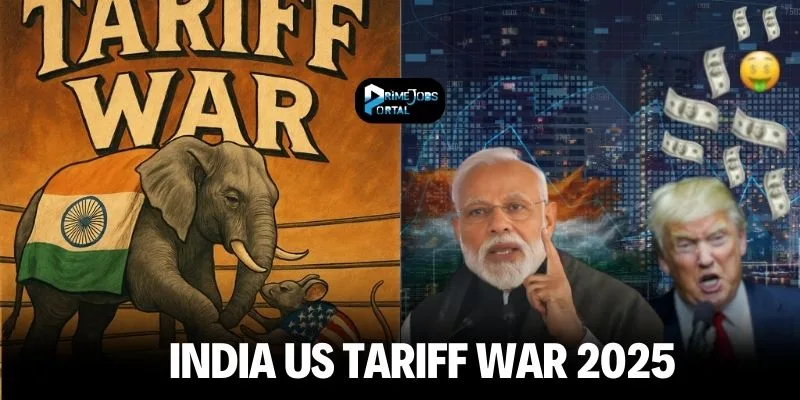India-U.S. relations have entered a critical phase in 2025, shadowed by escalating tariffs, diplomatic friction, and deep strategic dilemmas for both countries. The Trump administration’s decision to impose a sweeping 50% tariff on Indian goods matching the highest rates applied to other nations like Brazil. One of the highest rates ever marks a pivotal shift, with repercussions across agriculture, technology, luxury goods, and broader economic and strategic sectors.
Latest Developments in India US Tariff War 2025
- Over the past months, President Trump doubled existing tariffs on Indian imports to 50%, citing India’s ongoing purchase of Russian oil and “unfair trade practices”.
- Discussions between the two governments have stalled, and mistrust is mounting.
- Prime Minister Narendra Modi responded by reinforcing India’s commitment to economic self-sufficiency and pausing some major defense procurements from the U.S. though the latter claims were officially denied.
India US Tariff War 2025: Economic and Strategic Fallout
- The new tariffs hit labor-intensive sectors hardest textiles, gems, jewelry, garments, footwear, and furniture jeopardizing billions in exports and hundreds of thousands of jobs in India. Sectors such as shrimp and carpets face up to a 70% plunge in U.S. sales, risking loss of market share to competitors like Vietnam and Bangladesh.
- Meanwhile, Indian pharmaceuticals vital for affordable U.S. healthcare are temporarily exempt, as are some electronics and semiconductors.
- For America, these tariffs mean higher prices for consumers and reduced access to high-quality Indian goods, especially in luxury items and software services.
- The decision, heavily criticized even within the U.S. Congress is seen as a setback to strategic collaboration, long-term trust, and the Quad alliance’s larger goals.

Trump’s “America First” Motivation
- On camera, Trump presents the tariffs as a necessary defense of American industry and a lever to pressure India over trade imbalances and its Russian oil deals.
- On the other side, analysts view Trump’s frustration over New Delhi was it Declined Trump’s credit over Operation Sindoor in many platforms where Trump himself has taken credit more than 40 times since May 10.
- Geopolitical leverage, domestic political optics, and a desire for visible wins before the 2026 election are key drivers behind this sharp turn.
Strategic Relations and Sectoral Impacts
Software and Services
- India’s enormous software and IT export industry, less impacted by the current round of tariffs, remains crucial for U.S. tech companies and continues to grow.
- However, concerns loom over possible future restrictions like work visa caps.
Agriculture
- Agriculture export growth has slowed, and the sector is bracing for sharper declines if export demand drops further.
- Farmer protests and political unrest in Punjab and to protect the overall farming community in India are pressing Modi to promise support and tax relief.
Luxury Goods and Manufacturing
- Luxury goods, gems, and jewelry suffer steep costs, risking India’s ambition to become a global manufacturing hub.
- Indian exporters now face severe competition from regional economies like bangladesh, vietnam, to sustain in the american market as there goods are available at lesser price than Indian Products.

The Strategic Relationship and Key Sectors
- Despite the trade tensions, the strategic partnership between India and the US remains a crucial pillar of the relationship.
- This is particularly evident in the defense sector, where the US has become one of India’s largest arms suppliers.
- India and the US have signed four key defense agreements to facilitate the exchange of military information and technology.
- In the tech sector, while the US market is vital for India’s IT and software industry, cooperation is also growing in critical areas like cybersecurity, semiconductors, and AI under initiatives like the U.S.-India TRUST initiative.
- However, even here, there are points of friction, such as US export controls and restrictions on visa programs for Indian professionals
| India-US Trade Statistics | |||||
|---|---|---|---|---|---|
| Year | Total Trade ($) | India Exports to US ($) | US Exports to India ($) | Trade Balance ($) | Key Points |
| 2017 | 126.2 | 76.8 | 49.3 | -27.5 | 13% annual growth in total trade |
| 2018 | 142.6 | 83.9 | 58.7 | -25.2 | Imports growth outpaced exports |
| 2019 | 148.8 | 87.9 | 60.8 | -27.1 | US-India trade still rising |
| 2020 | 121.8 | 77.1 | 44.7 | -32.4 | Drop due to global pandemic |
| 2021 | 160.5 | 102.1 | 58.4 | -43.7 | Rapid recovery, exports surge |
| 2022 | 191.5 | 118.6 | 72.9 | -45.6 | All-time high trade volumes |
| 2024 | 212.3 | 87.3 | 41.5 | -45.8 | Services trade at $83.4 bn |
| 2024 | 238 | 87.3 | ~41 | -45.8 | Pre-tariff projections; major declines expected |
How India Is Overcoming India US Tariff War 2025 Challenges
- India’s response has been three-fold: doubling down on “Make in India” diversifying export markets, and leveraging domestic consumption as an economic buffer.
- Political messaging focuses on pride in self-reliance, and India is quietly strengthening its ties with China and Russia, balancing alliances for strategic autonomy.
- Even though in Short Run it will cause effect to indian exporters in Long Run it will make India a Sustainable country where it’s production is consumed with in India and make it a Self Sustain Country.
Conclusion on India US Tariff War 2025
- India U.S relations in 2025 are characterized by tension, recalibration, and resilience, shaped by President Trump’s aggressive tariff policy and India’s determination not to yield.
- Both nations are navigating the fallout, aware that their broader strategic partnership must ultimately survive these turbulent times, even as they pursue domestic and regional interests








